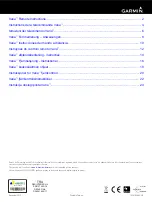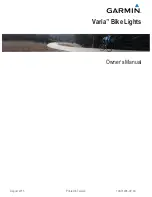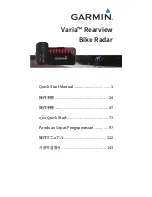
1. INSTALLATION:
The AS08 connects directly to your 12V power and NMEA 0183 device. No other connections or
configuration is generally required.
1.1 Location:
AS08 is designed to be securely positioned in an indoor environment. The AS08 should be
mounted to a dry, sturdy, horizontal surface. The cable can be routed either through the side of
the sensor housing, or through the mounting surface under the sensor.
For best performance, mount the AS08:
•
As close to the vehicle/boat
’
s centre of gravity as possible.
•
To accommodate the maximum pitch and roll motions, mount the
sensor as near to horizontal as possible.
•
Avoid mounting the sensor high above the water line because doing so also increases pitch
and roll acceleration
•
AS08 does not require a clear view of the sky.
•
Do NOT install near ferrous metals
or anything that can create a magnetic field
such as: magnetized materials, electric motors, electronic equipment, engines,
generators, power/ignition cables, and batteries.
1.2 Wiring:
The AS08 is designed to be used out of the box, for instant heading, rate of turn, pitch and roll
data to other NMEA 0183 devices. The default baud rate has been set as 4800bps, at 1Hz
updating frequency. If needed, the user can use the configuration tool to setup NMEA 0183
output baud rate, data frequency, or disable unnecessary messages.
The AS08 sensor has the following connections.
•
NMEA 0183 port and power
. A four
-
core M12 connector can be connected with the provided 2
meter cable. This can be connected to the NMEA 0183 listeners and the power supply. The user
can use the configuration tool to setup NMEA 0183 output data type, baud rate and data
frequency.
QK
-
AS08
This is an overview only. Always familiarize yourself with the product manual and
the manuals of any connecting devices before installation. Designed to be
connected by an experienced installer.
Wire
Function
Red
12V POWER
Black
GND
Green
NMEA
Yellow
NMEA OUTPUT
-
QK
-
AS08
1.3 Connecting to NMEA 0183 (RS422) devices:
The AS08 sends heading, rate of turn, pitch and roll sentences, in the NMEA 0183
-
RS422
(differential) protocol.
For RS422 interface devices , these wires need to be connected.
*
[1]
Swap NMEA input + and NMEA input –
wires if the AS08 does not work.
Ensure you check the above table and your device
’
s documentation carefully before connection.
1.4 Connecting to NMEA 0183 (RS232) devices:
Although AS08 sends out NMEA 0183 sentences via differential end RS422 interface, it also sup-
ports single end for RS232 interface devices, these wires need to be connected
*
[2]
Swap NMEA input and GND wires if the AS08 does not work.
•
USB port
. The AS08 is supplied with a type C USB connector. The USB cable can be linked di-
rectly to a USB port on a PC, supporting data output. The USB port is also used to configure the
AS08 and to calibrate (we only provide the calibration function to authorised distributors).
QK
-
AS08 wire
Connection needed on RS232 de-
vice
NMEA 0183
NMEA
NMEA Input+ *
[1]
NMEA output
-
NMEA Input
-
POWER
Black: GND
GND (for Power)
Red: Power
12v—
14.4
v Power
QK
-
AS08 wire
Connection needed on RS422
device
NMEA 0183
NMEA
GND *
[2]
NMEA output
-
NMEA Input
Black: GND
GND (for Power)
POWER
Red: Power
12v—
14.4
v Power
2. USING THE OPTIONAL USB OUTPUT
AS08 can be connected via USB to a Windows PC for:
1. Accessing heading, rate of turn, pitch and roll data on a PC (NMEA 0183 format). To do this,
the 3D model should be set as
‘
None
’
and the baud rate on the PC should be 115200bps.
2. Configuring additional settings (using Windows configuration tool)
a. Filtering of NMEA 0183 output sentences, to eliminate unwanted data.
b.
Adjusting heading data output frequency. The frequency of heading data transfer can be
set to 1/2/5/10 per second. 1Hz is the default setting and is generally recommended.
Please note: changing the setting to 10Hz may cause data overflow in some devices.
c. Adjusting the baud rate for NMEA 0183 output.
d.
Adjusting the brightness level of the LED on the panel. It can be set to be day or night
mode or off.




















